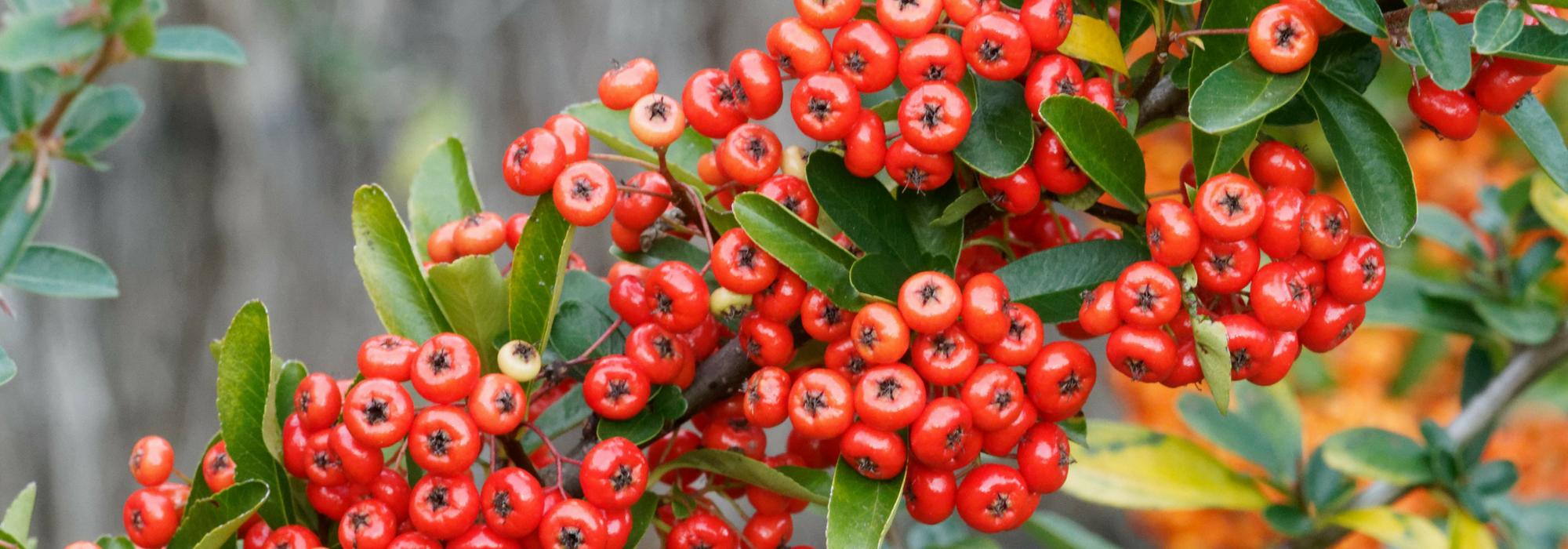
Pyracantha, firethorn: planting, pruning and care
Contents
Pyracantha, in a nutshell
- Pyracantha are thorny bushes, low-maintenance, valued for defensive hedges.
- They produce colourful red, orange, or yellow berries, which are very decorative during winter and appreciated by birds.
- Easy to grow and fast-growing, they create an impenetrable barrier in no time.
- They can easily be shaped into medium hedges and even trained against a wall.
- They bloom abundantly between May and July in clusters of small fragrant flowers that are highly melliferous.
A word from our expert
Pyracantha, or Firethorn, is one of the most decorative bushes during winter, alongside its cousin Cotoneaster, which is distinguished by its smooth-edged foliage and lack of thorns. Pyracantha has a much brighter, tougher, narrower foliage with slightly dentate edges and often rounded tips, in a very shiny bright green that highlights the profusion of glowing berries. The branches, if not pruned, gracefully droop under the weight of the fruits, which come in various colours ranging from golden yellow to dark red, including orange and scarlet.
Pyracantha was once disparaged due to its susceptibility to fire blight, an incurable disease specific to Rosaceae, which can affect fruit trees (apple, pear, plum…). The INRA* has focused on developing resistant cultivars from the SAPHYR range, and the most sensitive varieties have been banned from sale in France by a decree in 1994, due to the damage caused in orchards.
Modern varieties have restored the reputation of this spiny shrub, which had long been relegated to a defensive role and maintained without care. They are incredibly robust bushes and among the easiest to succeed even in poor soils, with multiple advantages that truly deserve to be integrated into the garden’s decor! They withstand urban pollution, wind, cold, and heat well.
The sharp thorns make it particularly suitable for designing defensive hedges, but its use is much broader. They elegantly arch to form the arches of a walkway, cover a wall with their lush vegetation while playing a significant ecological role. Birds such as thrushes, blackbirds, and robins delight in their berries during winter, with some building their nests well sheltered from predators, and the late flowering attracts a multitude of pollinators eager for pollen and nectar.
*INRA: National Institute for Agronomic Research
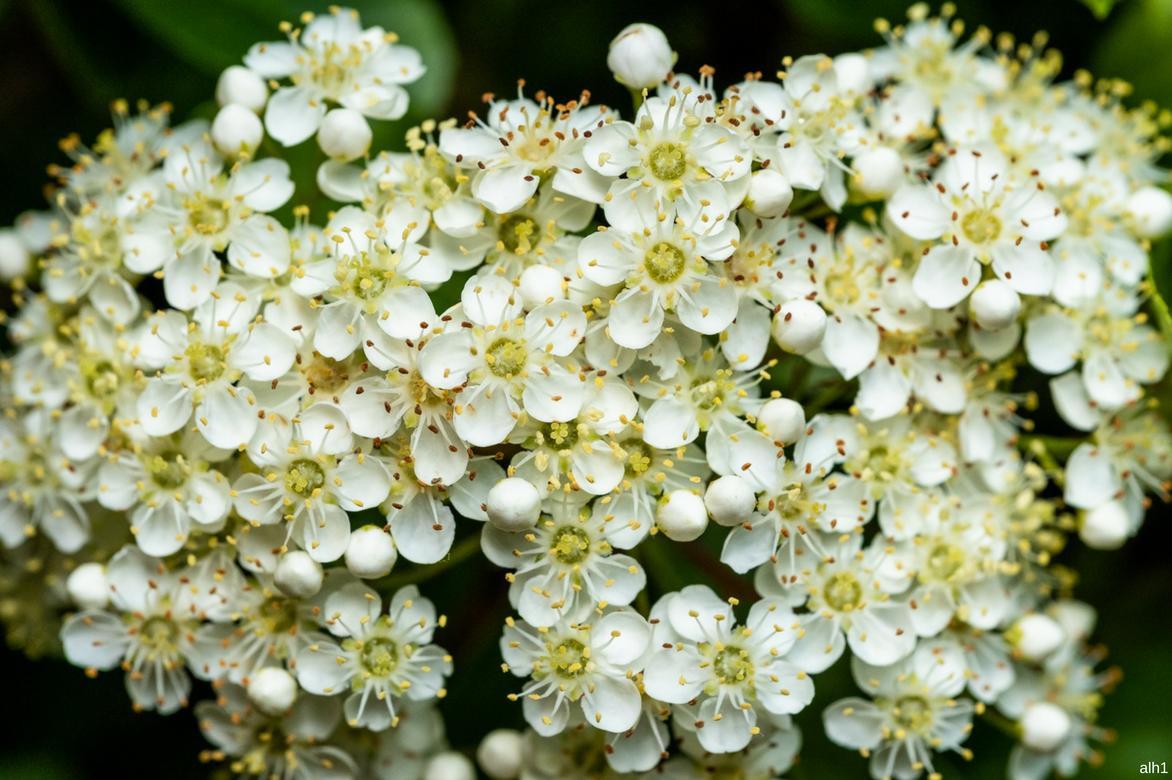
Flowers of a Pyracantha or Firethorn.
Description and Botany
Botanical data
- Latin name Pyracantha
- Family Rosaceae
- Common name Firethorn
- Flowering between May and July
- Height between 1 and 4 m
- Sun exposure full sun or partial shade
- Soil type any soil, even poor, without excess lime
- Hardiness Excellent (-15 to -28°C)
The genus Pyracantha comprises only 7 species, distributed in temperate Asia and around the Mediterranean, all consisting of thorny bushes up to 6 m tall that emit long branches gracefully arching under the weight of berries. The species coccinea, native to Turkey and the Caucasus and the source of many horticultural forms such as ‘Lalandei’ (obtained in 1874 in a nursery in Nantes), appears to be the hardiest of them all (-28°C). It has young pubescent shoots. The cultivars derived from the Chinese species atalantoides (syn. gibbsii) are those that were banned from planting and propagation in France in 1994 due to the risks associated with the spread of fire blight.
The term pyracantha comes from the Greek pyros, meaning fire, and acantha, meaning thorn, which translates to “thorn of fire”. The term “Firethorn” mentioned in the Bible also refers to the fiery hues of its berries.
The habit is quite dense, rather spreading, and often untidy in the absence of pruning. The grey bark cracks with age while the young greyish branches are glabrous but bristly with sharp thorns 3 cm long. These characteristics make it an ideal bush for creating medium to tall defensive hedges. However, the plant also lends itself well to training against a wall, which it can cover over 4 m in all directions or on arches. Some create beautiful topiaries from it.
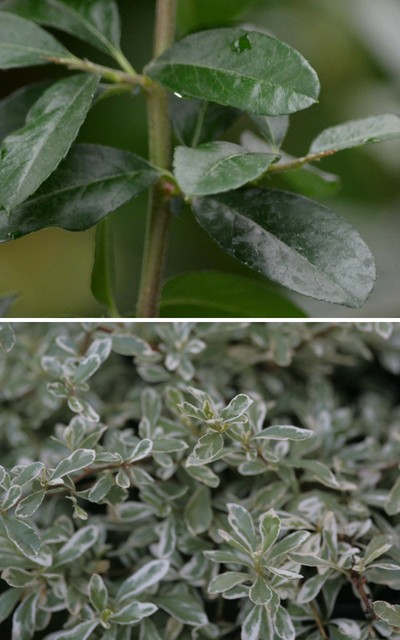
Foliages of Firethorns: Pyracantha ‘Orange Glow’, Pyracantha ‘Sparkler’.
The evergreen foliage is lanceolate sometimes rounded at the tip, 3 to 5 cm long with finely dentate edges. The prominent midrib causes a slight curling of the lamina in some cultivars, highlighting its glossy bright green appearance in contrast to the matte green underside. The dwarf variety ‘Sparkler’ features variegated grey-green foliage with cream and pink and bright orange-red berries. ‘Golden Sun’ is distinguished by its dark green foliage and golden yellow berries.
Its growth is rapid, but it is sometimes necessary to limit fruiting in particularly fruitful cultivars during the first few years to stimulate stem growth. However, it is important to preserve the long thorns that develop into branches the following year.
The very abundant flowering emitting a strong honey scent is extremely melliferous and is generally surrounded by a buzzing of bees that is pleasant to hear. It also attracts beautiful golden beetles and stick insects, these long insects that resemble twigs to hide. It occurs between May and July depending on the variety and forms clusters of corymbs with small white flowers 1 cm in diameter. The flower resembles that of hawthorn with its 5 rounded petals, preceded by 5 sepals with about twenty stamens and a pistil in the centre.
The fruiting takes on vivid colours from autumn. These are berries 5 to 8 mm in size, showing remnants of sepals opposite the peduncle like in apples. The fruits persist until winter and are truly a delight for birds. The varieties with yellow fruits are slightly less sought after, which can be an advantage for prolonging the appeal of the hedge.
As Rosaceae, pyracanthas are susceptible to the same diseases as most of our fruit trees, and France has been obliged to ban the sale of pyracanthas particularly susceptible to fire blight and capable of spreading it just like hawthorns. The varieties offered for sale are all forms permitted in French territory and normally resistant.

The berries of Pyracanthas are very decorative and are a delight for birds: P. ‘Golden Sun’, P. ‘Golden Charmer’, P. ‘Orange Glow’.
Read also
Cotoneaster: planting, pruning, careThe main varieties of Pyracantha
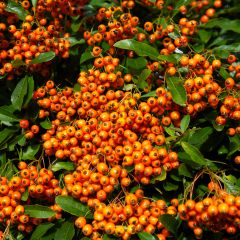
Pyracantha Orange Glow
- Flowering time June, July
- Height at maturity 4 m
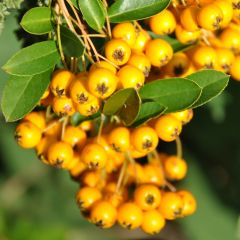
Pyracantha Soleil d'or
- Flowering time June, July
- Height at maturity 4 m
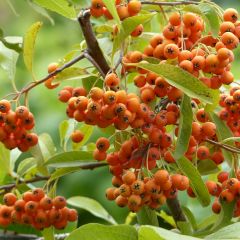
Pyracantha Golden Charmer
- Flowering time June, July
- Height at maturity 4 m
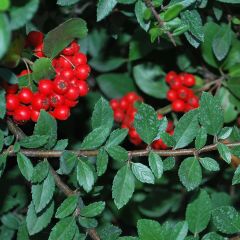
Pyracantha coccinea Red Column - Scarlet Firethorn
- Flowering time June, July
- Height at maturity 4 m
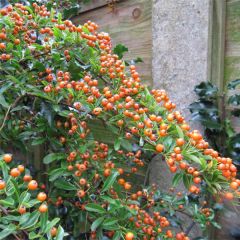
Pyracantha x coccinea Teton
- Flowering time June, July
- Height at maturity 3,25 m
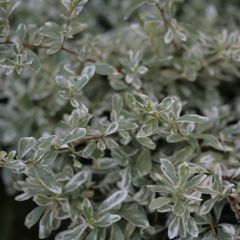
Pyracantha palustris Sparkler
- Flowering time June, July
- Height at maturity 1,50 m
Discover other Pyracanthas
View all →Available in 0 sizes
Available in 2 sizes
Available in 1 sizes
Available in 1 sizes
Available in 3 sizes
Available in 1 sizes
Available in 1 sizes
Available in 1 sizes
Available in 1 sizes
Young plantation
Where to plant Pyracantha?
Perfectly hardy (between -15 and -28°C), pyracanthas thrive throughout France in sunny or partially shaded locations, even in the shade in warm climates. However, fruiting is reduced in shade. They prefer well-drained soils that remain cool in summer but can withstand summer drought once well established. Plant them in any ordinary soil without excessive lime and well worked to aid establishment.
The Sparkler cultivar, which is dwarf in form, adapts to almost all soil types, even calcareous ones, preferring fertile, not too dry to fresh, well-drained soil. It tolerates negative temperatures around -15°C.
When to plant?
Plant Pyracantha preferably in autumn to ensure deep rooting before facing summer drought.
How to plant?
The ferocity of Pyracantha thorns necessitates maintaining a certain distance from pathways, whether pedestrian or vehicular. Additionally, observe a planting distance of at least 1.5 m with vigorous varieties of pyracantha planted alone and 50 to 80 cm with less vigorous ones or for forming hedges. Plan for a hedge thickness of at least 0.8 to 1 m so it can serve a defensive role. If you intend to grow it to 2 m or more, plant in 2 staggered rows to withstand wind.
A too dense, too shaded, or under-watered planting stimulates berry production from the second year at the expense of growth, weakening the plants that remain stunted. In this case, remove the berries as soon as they form so that 2 or 3-year-old frameworks can establish first.
- Soak the root ball in a bucket of water to thoroughly moisten it.
- Dig a planting hole, 50 cm in all directions or a trench in the case of a hedge.
- Add a 10 cm drainage layer (gravel, sand…) if your soil is clayey.
- Add manure or decomposed compost if the soil is sandy.
- Place the plant in the planting hole.
- Replace the soil and lightly compact.
- Water.
- Spread a layer of mulch at the base to maintain good moisture around the roots. This will also limit the growth of weeds.
Recovery is easy and quick and only requires monitoring watering during the first 2 years following planting.
To train pyracantha against a wall or on an arch:
- Install a sturdy and durable support that can bear the weight of the fruit-laden branches.
- Place the plant 30 cm from the wall or support.
- Then train the branches as they develop when the wood is still tender.
For container cultivation of small varieties like Sparkler:
- Place a drainage layer of 3-4 cm at the bottom of the pot (gravel, pottery shards, etc.).
- Add a mix composed of 1/3 soil, 1/3 potting soil, and 1/3 coarse sand.
- Add mulch to maintain moisture (B.R.F, bark, grass clippings…)
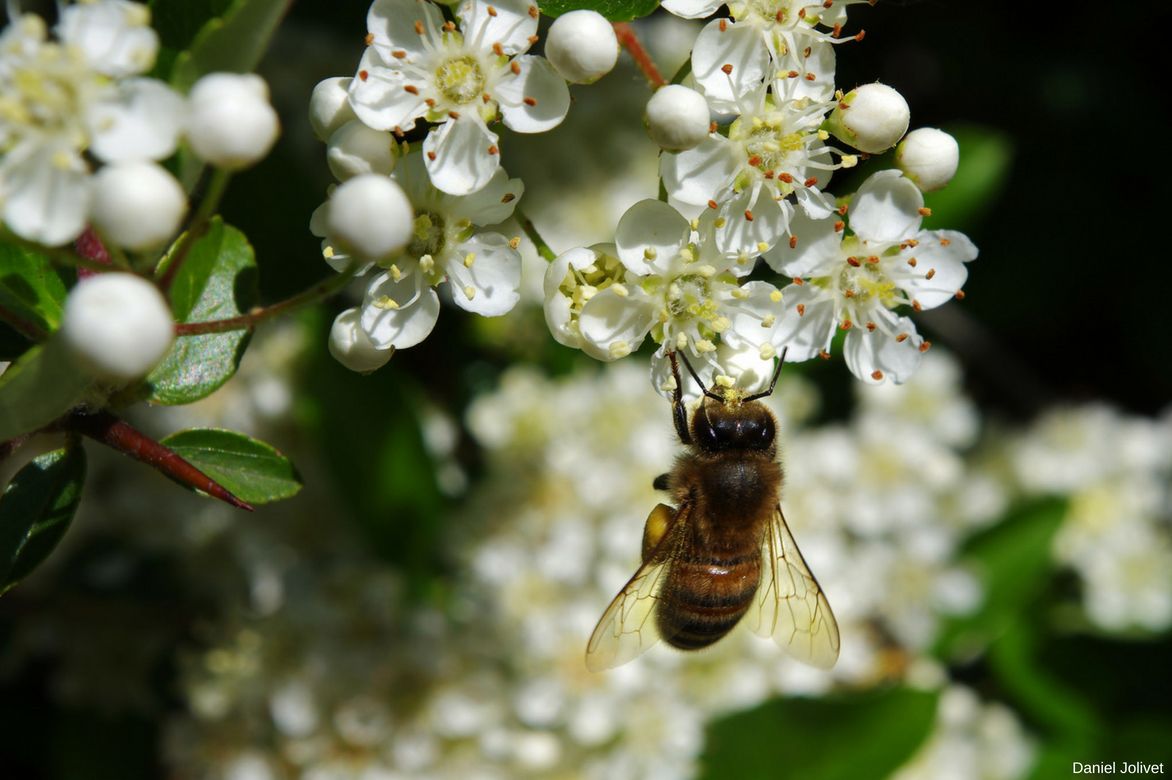
Pyracantha flowers are highly melliferous.
Maintenance and Pruning of Pyracantha
Water regularly for the first two years, especially during hot and dry periods. This bush requires no other maintenance, except for pruning if necessary, which should be light and carried out after flowering.
Pruning of pyracantha
To obtain well-branched plants from the base, start pruning young plants from the year of planting: remove 1/3 of the shoots in height at the beginning of spring, thus encouraging the lower branches to develop, and continue this pruning for 3 years.
For mature pyracantha, pruning is not really necessary if the bush is grown in isolation. It mainly serves to limit its growth and maintain a nice shape. A pruned Pyracantha will be less floriferous and fruit-bearing, as it flowers on two-year-old wood.
Hedge or topiary pruning of the firethorn
To maintain pyracantha as a hedge or in topiary form, cut back the long branches in March. Carry out two additional prunings after flowering in June and August if necessary using shears or a hedge trimmer. Given the abundance of flowers and the fact that buds form on two-year-old wood, pruning does not prevent fruiting from occurring. However, it should remain light, as a severe cut in spring can weaken the pyracantha and make it vulnerable to bacterial fire.
Pruning of a trained pyracantha
For a firethorn trained as an espalier, after staking the 6 or 7 stems intended to form the framework, cut back in March all unnecessary shoots that are turned towards the wall, too long, or bare at the base. Remove old fruit clusters to encourage new shoots.
Carry out another pruning in July-August to reduce the length of lateral shoots and highlight the upcoming berries. Be careful not to be too severe in pruning, as the regrowth will be more vigorous and maintenance tedious! It goes without saying that you should wear thick, long gloves to avoid scratches!
Possible diseases and pests
Generally very resistant to diseases, pyracanthas can be sensitive to bacterial fire (for sensitive varieties), leaf spots, and coral disease. Branches may suffer from attacks by scale insects, while young shoots and leaves can be affected by an invasion of aphids.
→ To learn more about this disease, consult our advice sheet: “Bacterial fire: identify and combat this disease”
Multiplication
Pyracantha is easily propagated by cuttings in summer using semi-ripe stems. Sowing is possible but does not produce plants identical to the parent plant, knowing that flowering occurs only after five years.

Fruiting of Pyracantha.
Propagation by Cuttings
Prepare a pot deep by filling it with potting soil mixed with sand, or carry out your cuttings in the ground if it is light, after aerating it with a fork, then moistening it.
- Take a lignified shoot 10 cm long from a current year’s shoot that is still green but hardened at the base.
- Remove the leaves near the base of the cutting, and trim the others to reduce the leaf surface area.
- Insert the cuttings two-thirds of their height, ensuring they do not touch each other.
- Gently firm the soil around to eliminate air pockets and ensure good contact between the potting soil and the cutting.
- Place them in a humid environment in the shade, for example, by covering them with a cut transparent plastic bottle.
- At the end of September, remove the bottle and place the cuttings under a frame until spring.
- Separate the rooted cuttings in spring to plant them in individual pots. Wait until the following autumn to plant them in the ground.
Sowing
Sow in autumn or spring after cold stratification of the harvested seeds, cleaned of the fruit pulp in autumn.
Uses and associations
Too planted, too pruned, too sick and too seen? The modern pyracantha is certainly a bush that withstands any growing conditions and especially does not suffer from geometric or more or less artistic pruning. A boon for uncultivated, even rocky soils and polluted areas, it at least has the advantage of bringing a bit of lushness and colour to neglected gardens and abandoned edges, while perfectly playing its role as a defender.

An example of a hedge association: Euonymus planipes, Pyracantha ‘Teton’, Cotoneaster lacteus, Pyracantha ‘Golden Charmer’.
Perfect for creating defensive hedges or topiaries, it will attract attention especially in autumn and winter with its abundant colourful fruiting, while shielding the garden from prying eyes and providing shelter for many small beneficial animals. You can honour it by allowing it to grow freely, in the distance, at the corner of a rather dreary building, or at the edge of a natural thicket; it will know how to be spectacular in these conditions, whether in flowers or fruits. In a hedge, mix it with other varieties to play on the different fruit colours, but also with other bushes like Cotoneaster, Holly, Eleagnus, deciduous or evergreen spindle trees, laburnum, bay laurel…
Pyracantha varieties generally blend very well together, allowing for a mix of fruits that remain decorative for longer, depending on their attraction to birds. However, some cultivars have a spreading habit, such as Pyracantha Alexander Pendula ‘Renolex’, which forms a vigorous ground cover or even a weeping subject if trained on a stem.
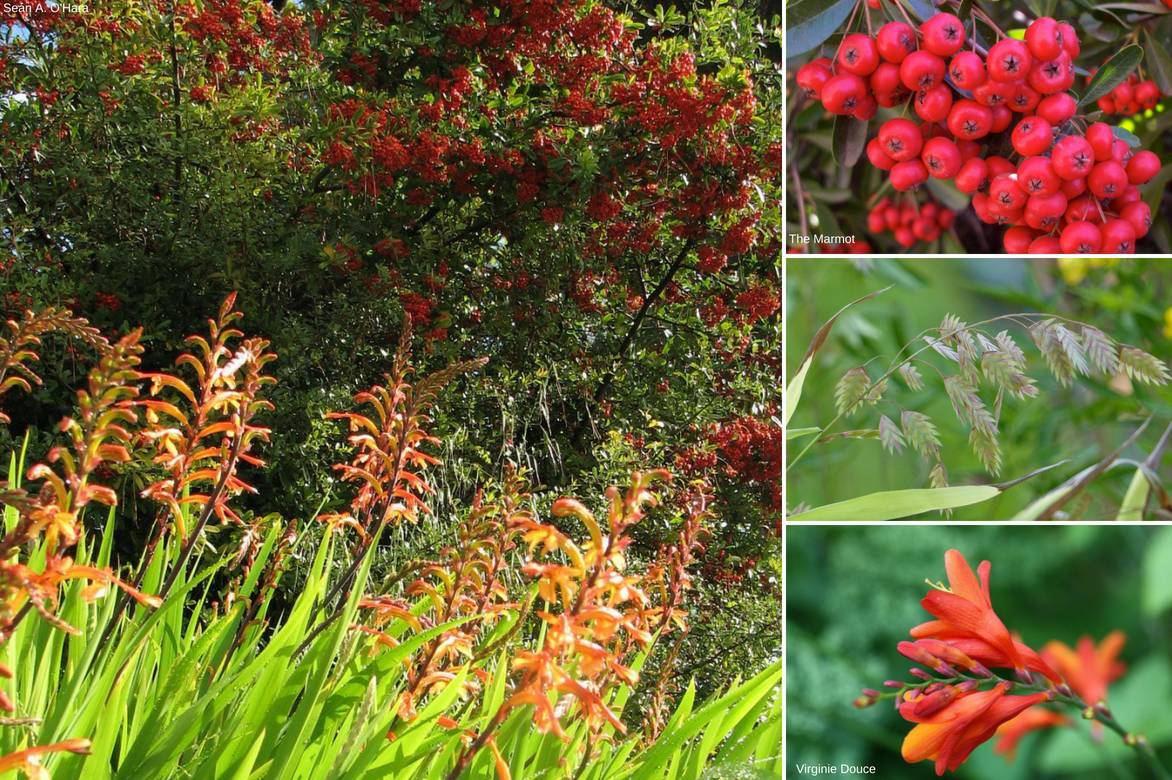
An example of an association: Red pyracantha (the variety ‘Coccinea Red Column’ is a beautiful subject with scarlet red berries), Chasmanthium latifolium and Croscosmia ‘Lucifer’.
The arrival of small-sized pyracanthas on the market expands its use as it can now be grown in a large pot on a balcony or terrace or form low free or trimmed borders. It can also be planted in isolation, at the front of flower beds, or within a group of flowering shrubs, climbing or bush roses with decorative fruits, or even Hydrangea paniculata with a small growth habit like Little Lime. Trained on a stem, it displays arching branches laden with small orange-red “apples”.
To go further
Discover our wide range of Pyracanthas.
Frequently asked questions
-
Are pyracantha fruits toxic?
Berries have very low toxicity for humans, with at most a few stomach aches in case of ingestion of several dozen fruits by children. The most significant issue is the presence of sharp thorns and its tendency to self-seed in the wild, although the plant is not currently considered invasive.
- Subscribe!
- Contents
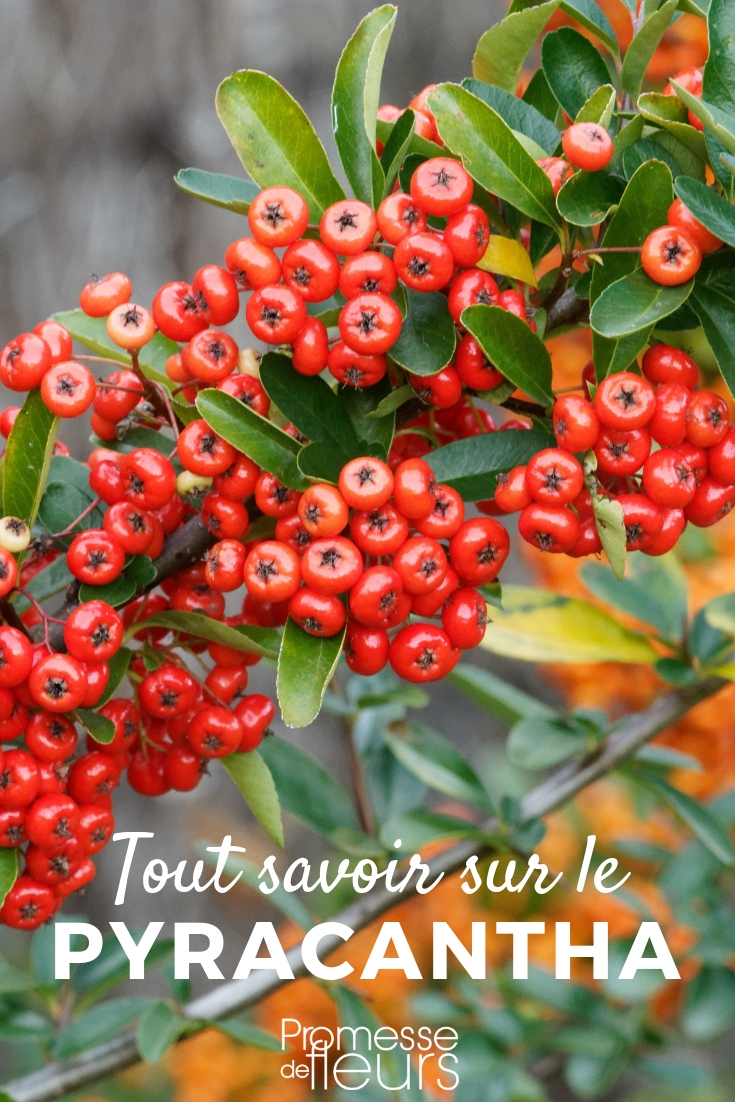































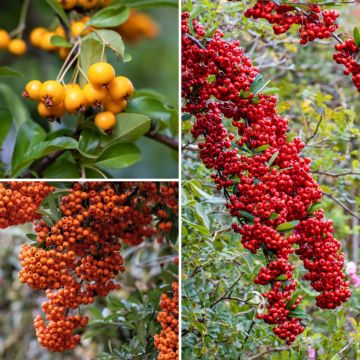

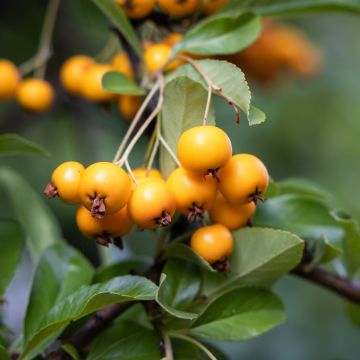
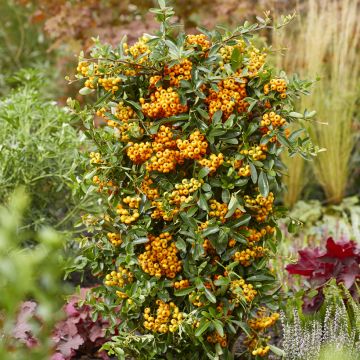
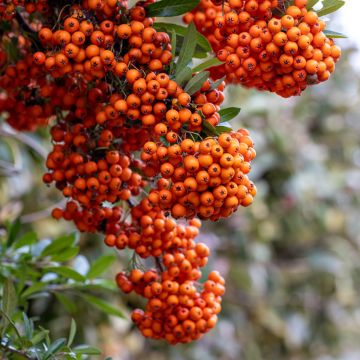
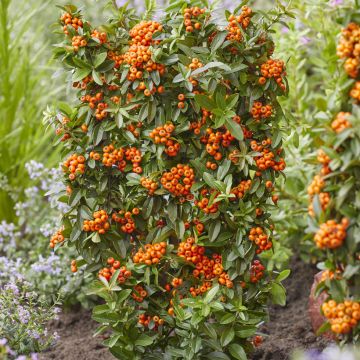
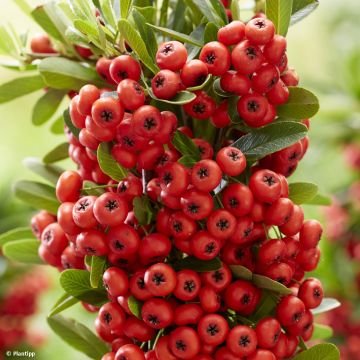
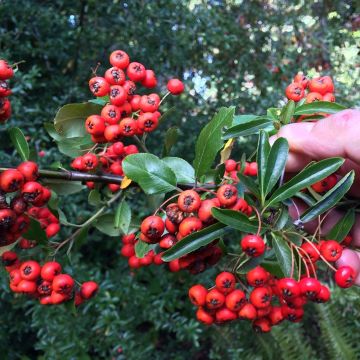


Comments